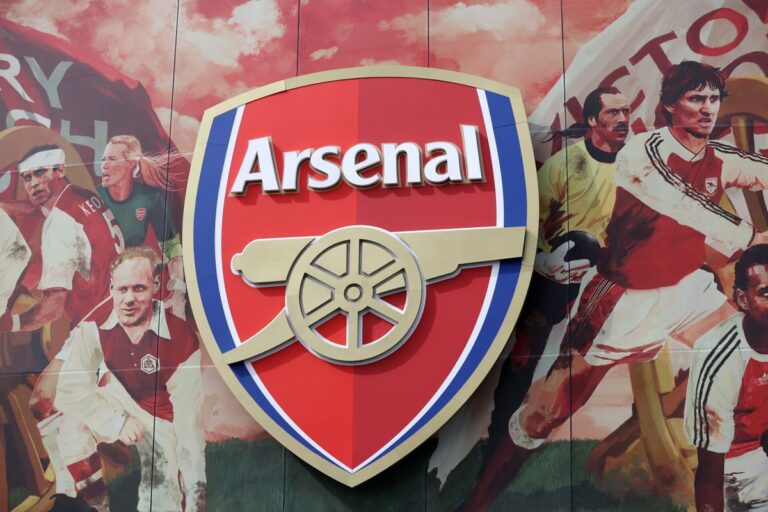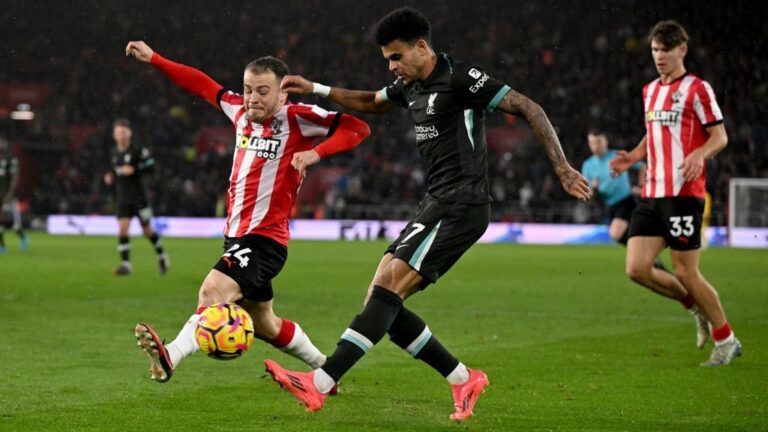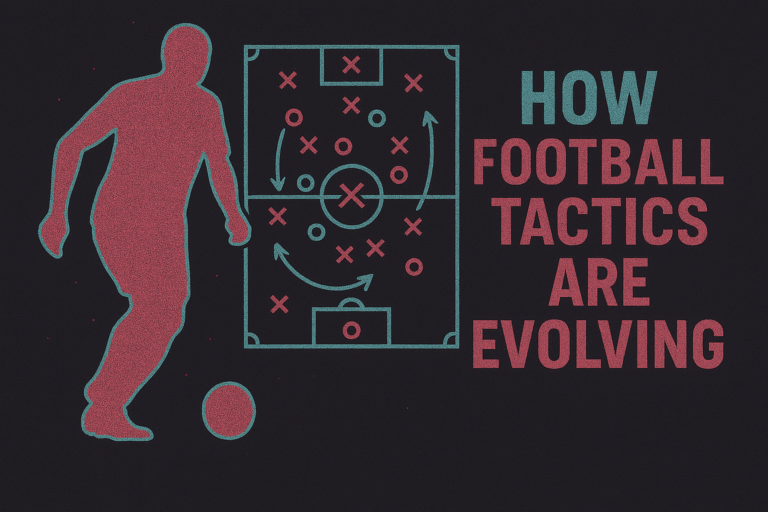
How Football Tactics Are Evolving: From Tiki-Taka to Vertical Pressing
Modern football tactics have undergone a remarkable evolution over the past two decades. From the tiki-taka era of patient possession to the high-octane surge of gegenpressing, and now into an age of tactical hybrids, the game’s strategic landscape is constantly shifting. This post traces that journey chronologically – starting with Pep Guardiola’s Barcelona and Spain’s dominance through short-passing mastery, moving into Jürgen Klopp’s intense pressing revolution, and finally examining today’s fluid systems blending both styles. We’ll break down key formations (4-3-3, 4-2-3-1, 3-4-2-1, 2-3-5), pressing zones, and match examples that illustrate these trends. The goal is a balanced narrative for the tactically savvy fan: analytical insights delivered as the compelling story of football’s tactical evolution.
The Tiki-Taka Era: Possession as a Form of Domination
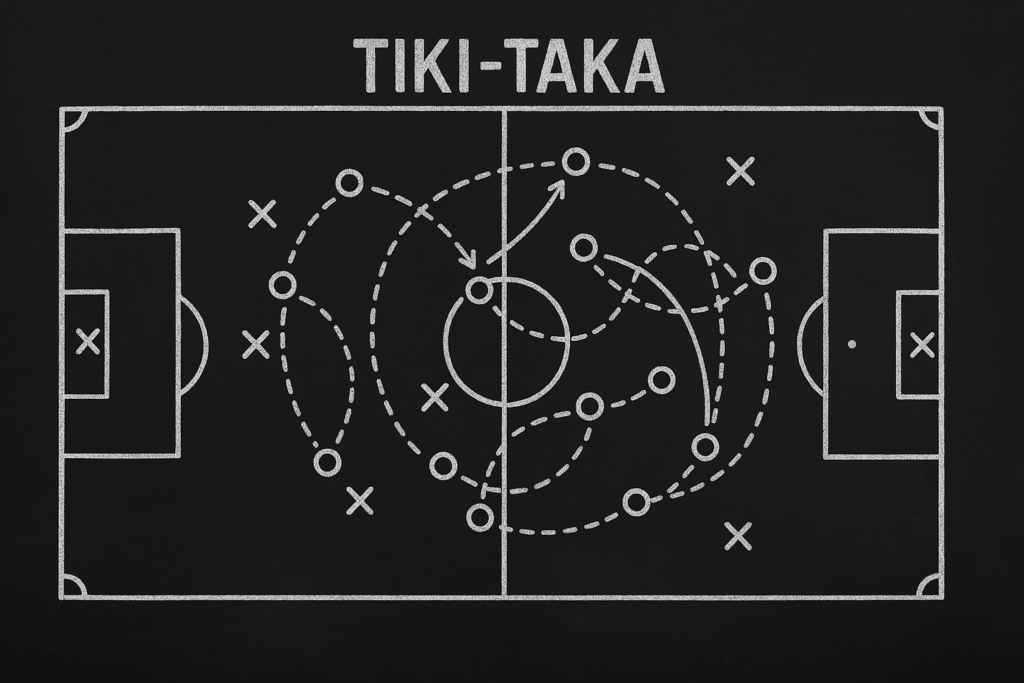
In the late 2000s and early 2010s, tiki-taka emerged as the defining style of play. Spearheaded by Guardiola’s Barcelona and mirrored by the Spain national team (2008–2012), tiki-taka was all about possession dominance. Teams sought to control ~60-70% of the ball, starving opponents and dictating the game’s tempo. The philosophy can be summed up as “short passing, patience and possession above all else”, involving sharp one- and two-touch combinations and roaming positional interchange among midfielders (Tiki-taka – Wikipedia). By moving the ball in intricate triangles and constantly offering support to the man in possession, tiki-taka teams could attack and defend at the same time – if you always have the ball, you never need to defend in the traditional sense.
Barcelona’s 4-3-3 shape under Guardiola created constant passing triangles (yellow lines) between players (red circles). This positional structure gave the team multiple short, safe passing options, allowing them to dominate possession with patient build-up (Barcelona tactics: Positioning, possession, pressure define club – Sports Illustrated). In basic terms, Barcelona lined up in a 4-3-3 with a single pivot (Sergio Busquets anchoring midfield) and two creative interiors (Xavi Hernández and Andrés Iniesta) between the lines. This shape easily formed triangles of support with short distances between players, letting Barça overload zones of the pitch through simple off-ball movement. Every player was comfortable receiving under pressure, a product of the famous rondo training drills that ingrained one-touch passing and quick decision-making. Up front, the wide forwards (like Pedro or David Villa) stretched the width, while Lionel Messi often operated as a falso nueve (false 9) – dropping off the front to link play and draw defenders out of position.
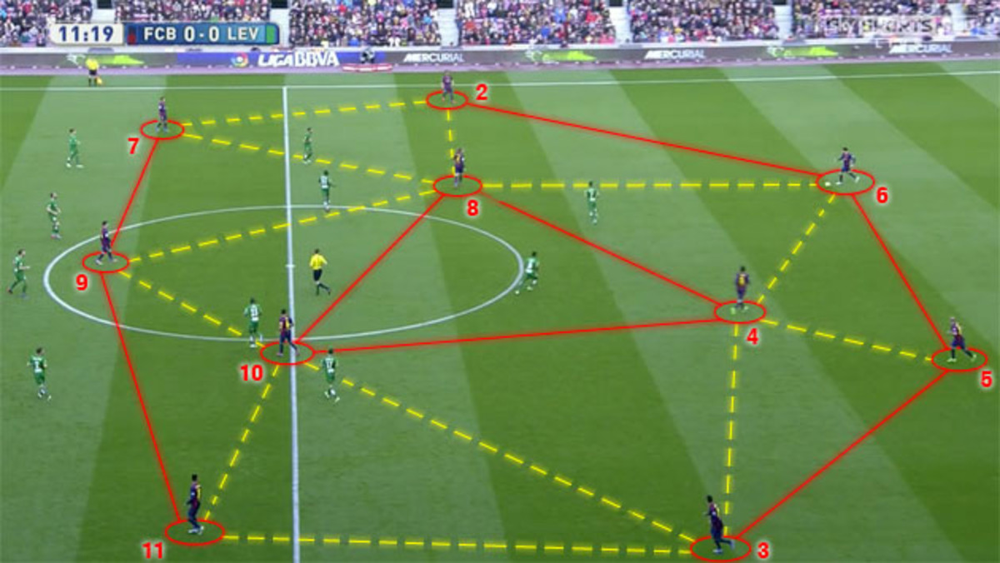
This style wasn’t just aesthetic; it delivered silverware. Spain, under Luis Aragonés and Vicente del Bosque, used tiki-taka to win Euro 2008, the 2010 World Cup, and Euro 2012. Their midfield (Xavi, Iniesta, Xabi Alonso, David Silva, Cesc Fàbregas) controlled games with record-setting passes and possession stats. In the Euro 2012 final, Spain exemplified tiki-taka’s apex, starting without a traditional striker and instead fielding Fàbregas as a roaming false 9. The result was a 4-0 masterclass over Italy, with Spain completing hundreds of passes and scoring flowing team goals. Around the same time at club level, Guardiola’s Barcelona (2008–2012) achieved unprecedented success – including a sextuple in 2009 (six trophies in a calendar year) – by playing this way. In the 2011 Champions League final, for instance, Barcelona’s 4-3-3 (with Messi, Villa, Pedro interchanging up front) completely suffocated Manchester United. The team’s positional play meant that whenever one Barça player had the ball, two or three nearby options were available, forming the famous short-passing triangles that made it nearly impossible for opponents to get a touch.
Key to tiki-taka’s effectiveness was that it was attacking and defensive in equal measure. With the ball, Barcelona and Spain probed patiently, waiting for a gap to thread a penetrating through-ball. Without the ball (on the rare occasions they lost it), they would immediately swarm to press and recover possession – an early hint of the pressing game that would soon take over world football. However, as tiki-taka’s dominance grew, so did the efforts to counter it. Opponents learned that disciplined deep defenses and quick counter-attacks could sometimes disrupt the rhythm of tiki-taka. The stage was set for a new tactical trend to emerge.
The Rise of Gegenpressing: High Intensity and Vertical Play
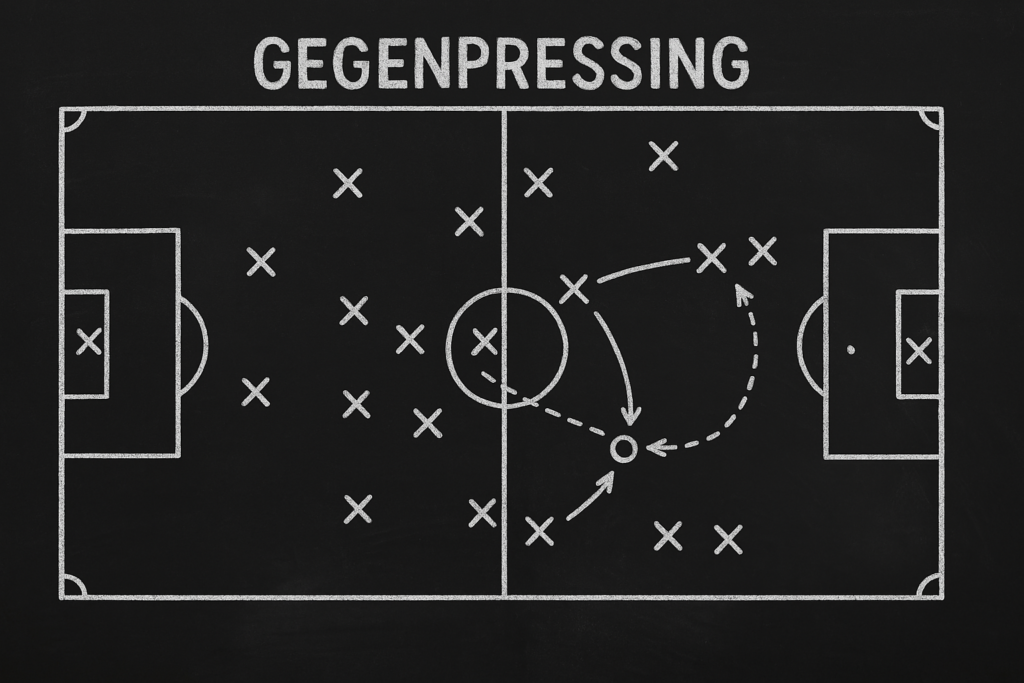
By the mid-2010s, the pendulum swung from patient possession to aggressive pressing. The German term “gegenpressing” – literally “counter-pressing” – became the buzzword of a new era. Popularised by Jürgen Klopp during his success with Borussia Dortmund and later Liverpool, gegenpressing is about hunting the ball down immediately after losing it, especially in the opponent’s half (Gegenpressing: How does the tactical style made famous by Klopp work? | Goal.com US). Rather than falling back to regroup, teams employing gegenpress seize on the moment of transition to win the ball when the opponent is most disorganized. As Klopp famously explained: “Gegenpressing lets you win back the ball nearer to the goal. It’s only one pass away from a really good opportunity. No playmaker in the world can be as good as a good gegenpressing situation”. In essence, the defensive press doubles as an attacking weapon – by winning possession high up, you’re immediately in a position to create a scoring chance.
If tiki-taka was typified by a 4-3-3 that could hog the ball, the gegenpressing wave often paired high press with formations like 4-2-3-1 or 4-3-3 that facilitated quick transitions. Klopp’s Dortmund (2008–2015), for example, usually played 4-2-3-1: a solid base of two holding midfielders and an array of fast attackers (the likes of Marco Reus, Mario Götze, Robert Lewandowski) who would swarm the opponent as soon as possession was lost. The forward line was instructed to do a lot of running – closing down defenders, cutting off passing lanes, and forcing panicked mistakes. When it worked, Dortmund’s transitions were lightning-quick: they would steal the ball and launch a direct attack in seconds, catching defenses out of shape. In their 2010–11 and 2011–12 Bundesliga title runs, Dortmund used this approach to outplay Bayern’s more possession-based style. A hallmark result was the 2013 Champions League semifinal where Dortmund’s energetic pressing and vertical attacks overwhelmed Real Madrid 4-1 in the first leg.
When Klopp moved to Liverpool, he brought gegenpressing to the Premier League – branding it “heavy metal football” compared to others’ “orchestral” football. Early on (2016–2018) Liverpool often fielded a 4-3-3 with a hard-pressing front three of Sadio Mané, Roberto Firmino, and Mohamed Salah, who became emblematic of the style. Their Champions League triumph in 2019 was, in part, an antidote to Pep Guardiola’s Man City – Liverpool could unsettle City’s possession game by pressing in waves and striking vertically on the break.
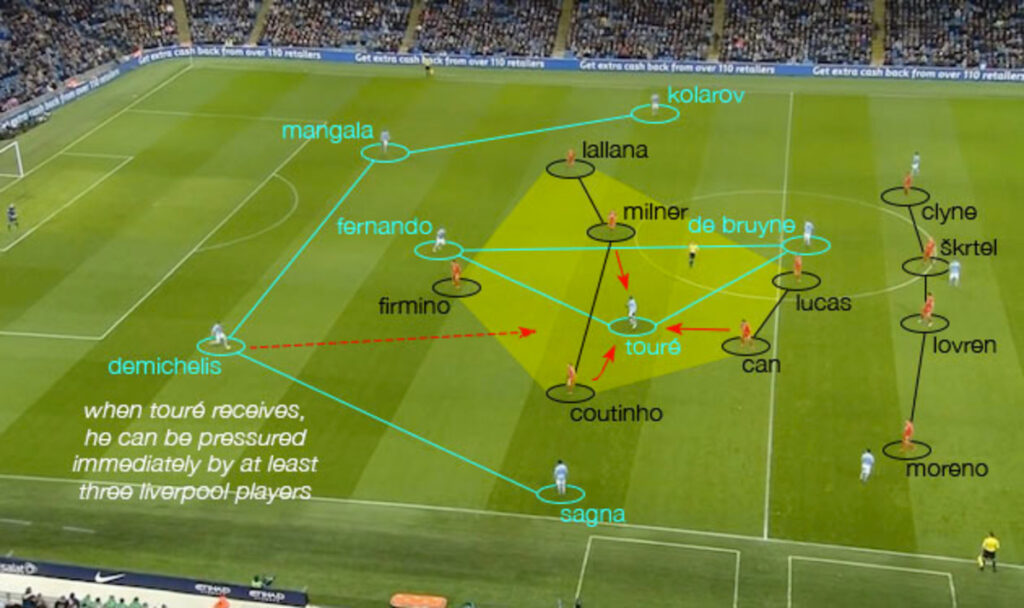
A notable example was the 2018 UEFA Champions League quarterfinal: Liverpool’s ferocious pressing at Anfield smothered Manchester City’s buildup, helping Liverpool win 3-0 in the first leg. Pressing heatmaps from that match (and others in that era) showed Liverpool’s defensive actions heavily concentrated in City’s half, indicating how high up the pitch they were winning the ball. In fact, as UEFA’s technical observers noted, Liverpool under Klopp often had a “clear idea to press high from the start… sending the ball to one side and pressing there”, using the touchline as an extra defender. By funneling opponents into pressing traps near the sideline, Liverpool could regain possession in dangerous areas and immediately spring towards goal.
It wasn’t just Klopp. The gegenpressing philosophy spread across Europe, especially among German-influenced coaches. Ralf Rangnick (often dubbed the godfather of gegenpressing) had laid the groundwork, and younger coaches like Thomas Tuchel and Julian Nagelsmann carried it on( Coaches' Voice | Counter-pressing and the gegenpress: football tactics explained ). At RB Leipzig, Nagelsmann implemented a more measured high press. Leipzig built a reputation for counter-pressing, but Nagelsmann evolved the team into a “more balanced unit” that didn’t press recklessly at all times. He was known for tactical flexibility: one week Leipzig might line up in a 3-4-2-1, another week a 4-3-3, adjusting the pressing structure to the opponent. In a Champions League clash against Klopp’s Liverpool, pundits described it as “Klopp’s pragmatic gegenpressing vs Nagelsmann’s methodical high-press” – two kindred philosophies with a twist. Leipzig’s press under Nagelsmann often aimed to force play wide and then aggressively swarm, similar to Liverpool, but he also wasn’t afraid to drop into a mid-block in phases, conserving energy and then striking in bursts. This indicated an important point in the evolution: the pure all-out press was being refined into something more sustainable. (RB Leipzig’s tactical flexibility & methodical pressing make them a unique threat to Liverpool | Squawka)
By the late 2010s, pressing had become ubiquitous – even teams not as talent-rich as Liverpool or Dortmund adopted variations of it. Mauricio Pochettino’s Tottenham, Marcelo Bielsa’s Leeds, and others showed that hard-running, organized pressure could level the playing field against technically superior sides. Data like PPDA (passes allowed per defensive action) became popular measures of how intense a team’s press was – with lower numbers meaning a team presses more frequently. Fans and bettors alike noticed that a team’s pressing style could dramatically influence game outcomes (for example, high-press sides might force high-scoring, chaotic games, a factor to consider in over/under bets). However, as pressing became the norm, top coaches again started to adapt, seeking a balance between keeping the ball and hunting it down. This brings us to the current era, where tactical approaches are more hybrid and fluid than ever.
Tactical Fluidity and Hybrids: The Modern Mix
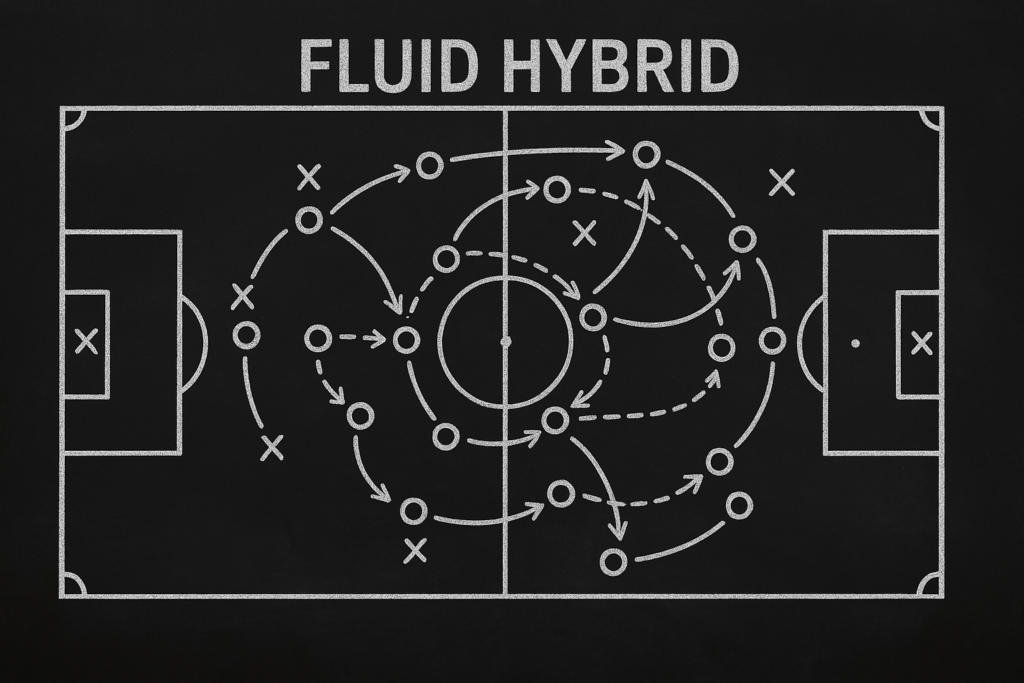
In today’s game, elite teams have learned to blend the best of both worlds – marrying possession structures with intensive pressing, and adding new innovations. Tactical systems have become highly fluid, with teams morphing shapes between phases (attack vs defense) and even within games. Let’s explore some of these current trends and examples:
Pep Guardiola’s philosophy has evolved since his tiki-taka days. At City, he still values keeping the ball, but he has merged aggressive counter-pressing with his possession-based style ( Coaches' Voice | Counter-pressing and the gegenpress: football tactics explained ). One signature innovation is the use of inverted full-backs – where fullbacks like João Cancelo (now John Stones) drift into central midfield when City have possession. This creates a temporary 2-3-5 shape: the back four becomes a back two, and the extra players join midfield to form a “box” that overloads the center. For example, City often build up with 2 center-backs, a midfield trio (sometimes the two inverted fullbacks alongside Rodri), and five attackers spread across the front line. The effect is numerical superiority in midfield and immediate pressure on the ball when possession is lost (since those extra central players are ready to counter-press). City’s recent title-winning sides exemplify this hybrid: they can orchestrate 20-pass scoring moves or, when they lose the ball, swarm to win it back within seconds. It’s tiki-taka with teeth. In big matches, Guardiola has even adjusted his formation mid-game – deploying a 3-2-4-1 or other fluid shapes – to ensure control. The modern Manchester City is thus a prime example of tactical fluidity: one moment patiently circulating the ball in a positional play structure, the next moment snapping into a coordinated press to smother a counter-attack.
A rising force in the Bundesliga, Xabi Alonso’s Leverkusen showcases a clever blend of vertical press and possession. Alonso often lines his team in a 3-4-2-1 formation, using asymmetrical wing-backs (one stays back as a third center-back while the other pushes almost into a winger role). In possession, Leverkusen will build out from the back patiently – even inviting the opponent to press them – in order to open up space further forward (Tactical Masterclass: How Xabi Alonso's Ingenious Strategies Revitalized Bayer Leverkusen – Soccer-Coaches). But once the ball advances, they attack very directly, utilizing the speed of players like Jeremie Frimpong and Moussa Diaby. Tactically, Alonso has introduced a “nuanced counter-pressing strategy”: instead of an all-out press, Leverkusen often forms a 3-2 box midfield shape out of possession, which corrals opponents toward the flanks, setting traps for unsuspecting full-backs. In other words, they invite the opponent to play wide and then spring the press in those wide areas. Upon winning the ball, Leverkusen will immediately exploit the vacated spaces with quick vertical passes – a very efficient transition style. This approach paid dividends in a recent league match where Leverkusen beat Bayern Munich 3-0, with Alonso’s men both absorbing pressure and snapping forward on the break. It’s a great example of a hybrid philosophy: not as patient as pure tiki-taka, but not as helter-skelter as classic gegenpressing. Alonso’s team can keep the ball to control a game, yet they’re also experts at striking quickly when an opponent is out of shape.
One of the more unique modern approaches is Gasperini’s man-to-man pressing system at Atalanta. While most teams press in zones or via trigger cues, Atalanta famously defends “everyone vs everyone” all over the pitch. Gasperini instructs his players to “occupy each player of the opposition with one of his own”, embracing a risky full-field man-marking ethos. This means if an opponent drops deep to receive, an Atalanta player follows him deep; if an opponent pushes high, an Atalanta defender goes high too. The intent is relentless pressure: Atalanta want to win the ball back very high up the pitch whenever possible (Pressing the issue: A look at how Atalanta press under Gian Piero Gasperini – The Kippax tactician). Their back three will often be positioned near the halfway line, compressing space. The upside of this approach is that it disrupts teams that rely on structured build-up – as Liverpool discovered when Atalanta beat them 2-0 in a 2020 Champions League group match, suffocating Liverpool’s usual passing options. The downside is the risk: a single beaten marker can leave huge gaps. Still, Atalanta’s success (regular Champions League qualification and giant-killing results) shows that a well-drilled man-press can thrive in the modern era, adding another flavor to the tactical spectrum.
Not all innovation is about pressing; at Brighton, the focus has been on an evolved possession build-up. De Zerbi has taken a mid-table squad and implemented one of the most sophisticated build-up structures in Europe (Pep Guardiola himself praised Brighton as “the best in the world at build-up”). Brighton often splits their center-backs extremely wide, with the goalkeeper (e.g. Robert Sánchez or Jason Steele) acting almost as a third defender centrally (How Brighton's Build-Up Under De Zerbi Solves the Pivot Problem). The full-backs stay low to offer outlets, and two midfielders drop in to create multiple short triangles in their defensive third. This bold approach lures opponents to press high – at which point Brighton uses quick one-twos and vertical passes to break that press. Essentially, they gamble that they can pass their way through your high press; if they do, the reward is lots of space to attack into (since the opponent committed numbers forward). We’ve seen this yield brilliant team goals where Brighton play out from their six-yard box to score at the other end in a matter of seconds. Their approach exemplifies how even smaller clubs now employ extremely technical, tactical systems once reserved for the elite. And they don’t eschew pressing either – when Brighton lose the ball, they counter-press aggressively, albeit not quite at Liverpool’s intensity. It’s this balance of patient build-up and quick pressing that makes them a fascinating watch.
Inspired by Guardiola’s methods, Arteta has transformed Arsenal with a modern positional play setup. In possession, Arsenal often arrange into a 2-3-5 formation – described by pundits as a “five and five” approach (five dedicated to attack, five to defense). Typically, the two center-backs stay back, the full-backs (like Oleksandr Zinchenko and Ben White) step into midfield alongside a holding midfielder (Thomas Partey), and five players form the forward line (e.g. wingers Bukayo Saka and Gabriel Martinelli hugging the touchlines, two attacking mids like Martin Ødegaard and Granit Xhaka in the half-spaces, and a striker up top). This structure, similar to Man City’s, creates superiorities in midfield and floods the front line with options. The results in 2022–23 saw Arsenal jump from a fifth-place team to genuine title contenders. Off the ball, Arteta’s Arsenal also press high, though in a slightly more measured way than Klopp’s Liverpool. They often press in a 4-4-2 shape, with Ødegaard pushing up next to the striker to lead the press. The key for Arsenal has been adaptability – they can build with patience through that 2-3-5, but they can also fast-break when they force a turnover. This hybrid approach has made Arsenal much more unpredictable and resilient. Notably, this trend of a front five attack isn’t just Arsenal: Manchester City popularized it in England, Brighton use a similar attacking shape, and even Klopp’s Liverpool pivoted to a 3-2-5/2-3-5 structure in late 2022–23 by moving Trent Alexander-Arnold into midfield (Man City vs Arsenal: How Mikel Arteta's tactics turned the Gunners into title contenders this season | Football News | Sky Sports). It underscores that the top teams are converging on certain principles: dominate midfield with numbers, and pin the opponent back with multiple forward threats.
Tactical Formations Evolution Summary
To summarize the evolution in formation and focus, here’s a quick comparison:
| Era & Style | Notable Teams (Coach) | Typical Formation | Key Traits |
|---|---|---|---|
| Tiki-Taka (2008–2012) | Barcelona (Guardiola); Spain NT (Aragonés/Del Bosque) | 4-3-3 (False 9) | Heavy possession, short-passing triangles, positional play, patient build-up. Minimal risk-taking; wear opponents down. |
| Gegenpressing (2013–2018) | Dortmund/Liverpool (Klopp); RB Leipzig (Rangnick/Nagelsmann) | 4-2-3-1 or 4-3-3 | High press intensity, counter-press on loss, vertical quick transitions. Focus on winning ball in opponent’s half (counter-counter-attack) ([Gegenpressing: How does the tactical style made famous by Klopp work? |
| Fluid Hybrid (2019–Present) | Man City (Guardiola); Arsenal (Arteta); Leverkusen (Alonso); Atalanta (Gasperini); Brighton (De Zerbi) | Dynamic shapes (e.g. 4-3-3 morphing to 3-2-5 in attack, 3-4-2-1, etc.) | Mix of possession and pressing. Inverted roles (full-backs into midfield), “5-and-5” attacking structure |
Conclusion: The Ongoing Evolution
Football’s tactical evolution from the tiki-taka era to the age of vertical pressing and beyond shows that there is no permanent winning formula – only temporary advantages. Each cycle triggers a response: the dominance of possession play led others to devise intense pressing strategies; widespread pressing has in turn led to new hybrid models. Today’s top teams are tactically versatile, able to slow the game down or speed it up as needed. Managers now prepare multiple game plans and in-game formations, and players are coached to be multi-functional (a full-back may become a midfielder, a winger may play as an auxiliary striker, etc.).
For fans who love tactical depth, it’s a thrilling time. We see matches not just as 11v11 talent contests, but as chess matches on grass – where a tweak in pressing height or a clever positional rotation can decide the outcome. For those into betting, understanding these tactical nuances can offer an edge: knowing, for instance, that a mid-table team like Brighton will confidently play out from the back against a big-six opponent might influence a bet on possession stats or an upset result.
From the poetic passing of tiki-taka to the thunderous rush of gegenpressing and the sophisticated hybrids we see today, football’s tactical journey is a story of constant innovation. The beauty of the sport is that it never stands still – coaches and players will keep experimenting. Who knows what the next trend will be? Perhaps a revival of old-school libero systems or a new twist on pressing we haven’t seen yet. One thing is certain: as soon as one approach reaches its peak, the tactical minds of football will be hard at work devising the next evolution. And we, as enthusiasts, will be right here eagerly analyzing it, one formation at a time.




